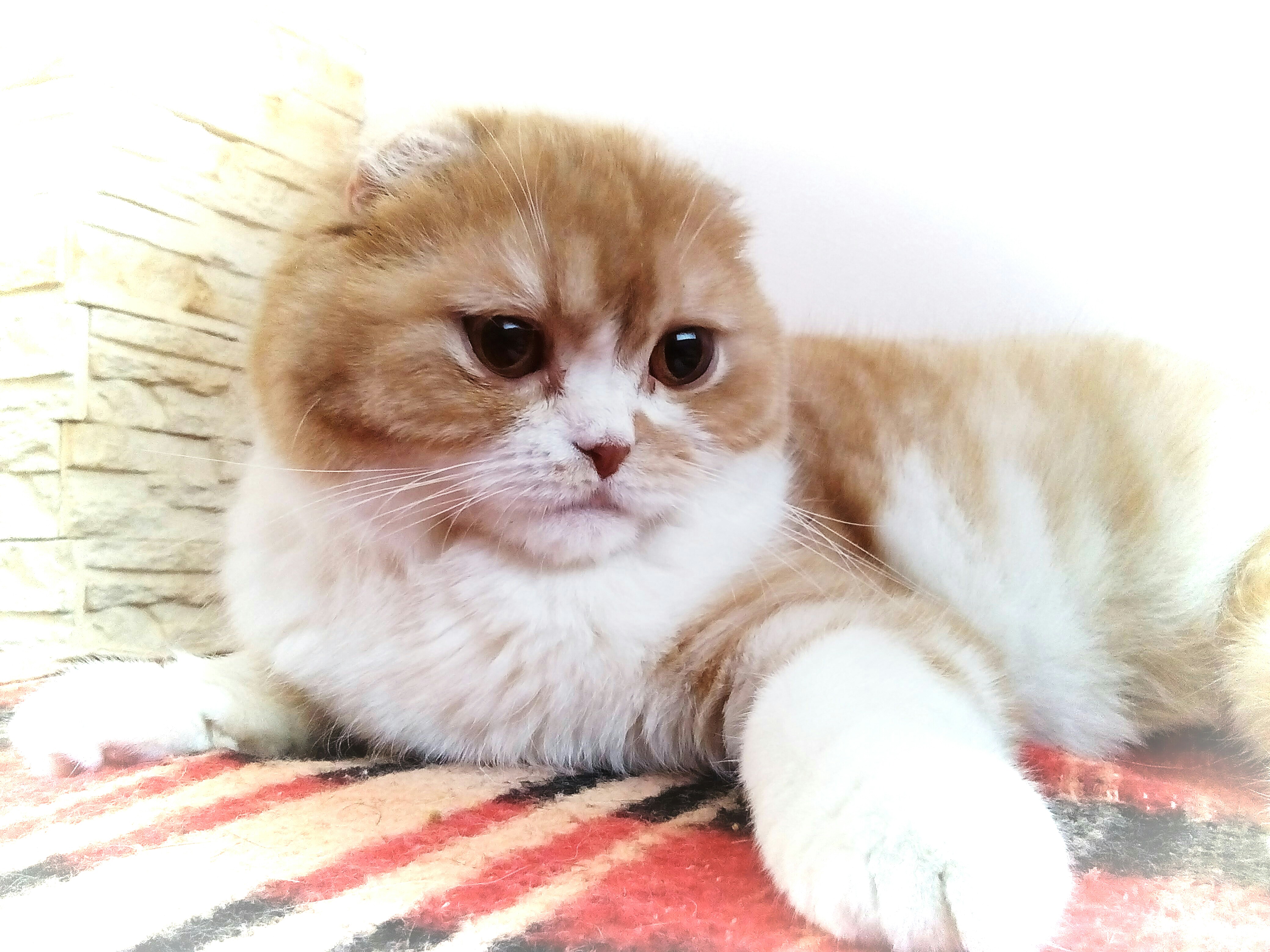
Breed Profile
First discovered in a barn near Coupar Angus in Scotland, the Scottish fold is best known for her distinctive folded ears, which are the result of a spontaneous natural mutation. The ears fold forward and downward, and the resulting impression of a wide-eyed owl or cuddly teddy bear has captured the hearts of many cat lovers. In addition to their characteristic ears and unique look, folds are mellow and affectionate, perfect for folks who want a loving companion that’s not too active.
Appearance
The breed’s distinctive folded ears are produced by an incompletely dominant gene that affects the cartilage of the ears, causing the ears to fold forward and downward, giving a cap-like appearance to the head. Smaller, tightly folded ears set in a cap-like fashion are preferred to a loose fold and larger ear. The large, round eyes and rounded head, cheeks, and whisker pads add to the overall rounded appearance. Despite the folded ears, folds still use their aural appendages to express themselves – the ears swivel to listen, lay back in anger and prick up when the treat bag rustles.
The fold’s body also gives the impression of roundness. It is medium-sized, rounded, well-padded and even from shoulder to pelvis. The tail is medium to long, tapered and in proportion to the body.
Scottish folds are found in both longhaired and shorthaired varieties. The longhaired fold has a medium-long to long coat that is soft and full of life and boasts a full ruff, leg britches, toe tufts, ear furnishings and a huge plume of a tail. The shorthaired fold has a short to medium-short, dense, resilient coat that stands away from the body.
In most associations, almost every color and pattern are accepted except those that indicate hybridization, such as the Siamese pointed pattern and colors. However, a few associations accept all colors and patterns, including the pointed pattern.
History and Origin
In 1961, Scottish shepherd William Ross noticed a cat with unusual folded ears at a neighbour's farm near Coupar Angus in the Tayside Region of Scotland. This first fold, Suzie, was a white barn cat of unknown parentage. Realising the uniqueness of the cat’s ears, Ross and his wife, Mary, acquired one of Suzie’s kittens a year later, a white female named Snooks.
The Rosses started a breeding program with Snooks and worked to establish the new breed. At first, they called the breed “lop-eared,” like the rabbit. British shorthairs were used to strengthen and enlarge the gene pool. The Rosses began showing and registering their unique cats with the Governing Council of the Cat Fancy (GCCF). Other breeders got involved and by the end of the decade the breed was renamed the Scottish fold.
In the early 1970s, however, the GCCF stopped registering folds because of concerns about ear disorders such as infections, mites and deafness – concerns that turned out to be unfounded. Still, the breed never achieved the fame it has attained in North America. Folds were first introduced to the United States in 1970 when three of Snooks’ kittens were sent to Dr. Neil Todd in Massachusetts, who was researching spontaneous mutations. Other folds were later imported, and British and American shorthairs were used in the breeding program. All genuine Scottish folds can be traced back to Suzie.
In 1978, the Cat Fanciers’ Association (CFA) granted the Scottish fold championship status. In a relatively short time, the fold earned acceptance in all the cat associations and a place in the U.S. cat fancy’s top 10 most popular breeds. Today, the fold is the eighth most popular, according to CFA’s registration totals.
The longhaired version of the fold was not officially recognized until the mid-1980s, although longhair kittens had been appearing in Scottish fold litters since the beginning.
Personality
Scottish folds are mellow, loving, sweet-tempered and adapt quickly to new environments and people. While folds will deign to allow others to cuddle and pet them, they are very loyal and tend to bond with one person in the household, whom they will follow from room to room like devoted, lop-eared puppies. They thrive on attention and interaction with their chosen humans and are agreeable to almost any suggestion – as long as it can be accomplished from a reclining position.
Despite their devotion, they are not clingy or demanding cats and usually prefer to be near you rather than on your lap. They vocalize only when they have something very important to say, like “Feed me,” but even then their voices are usually quiet. They enjoy a good game of fetch now and then and stay playful and kittenish well into adulthood.

Grooming
Shorthaired folds need minimal grooming. Because their coat is dense, however, it’s necessary to comb their fur with a good steel comb once or twice a week to remove dead hairs. Longhaired folds require more grooming – combing with a good steel comb twice or three times a week will prevent mats and keep the fur looking its best.
The folded ears cause an increased production of wax buildup in some cats, making ear cleaning a necessary part of bi-monthly grooming for both long and shorthaired varieties.





